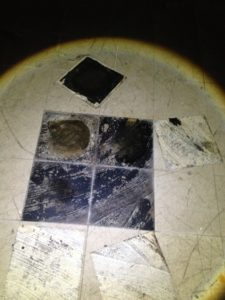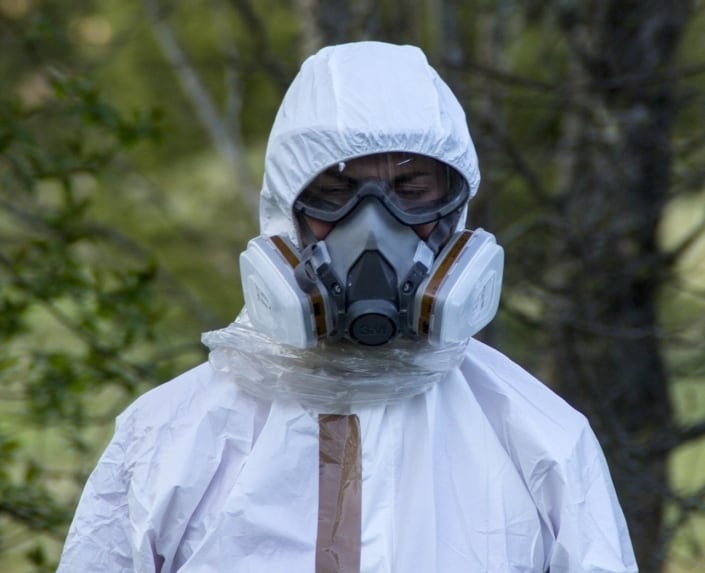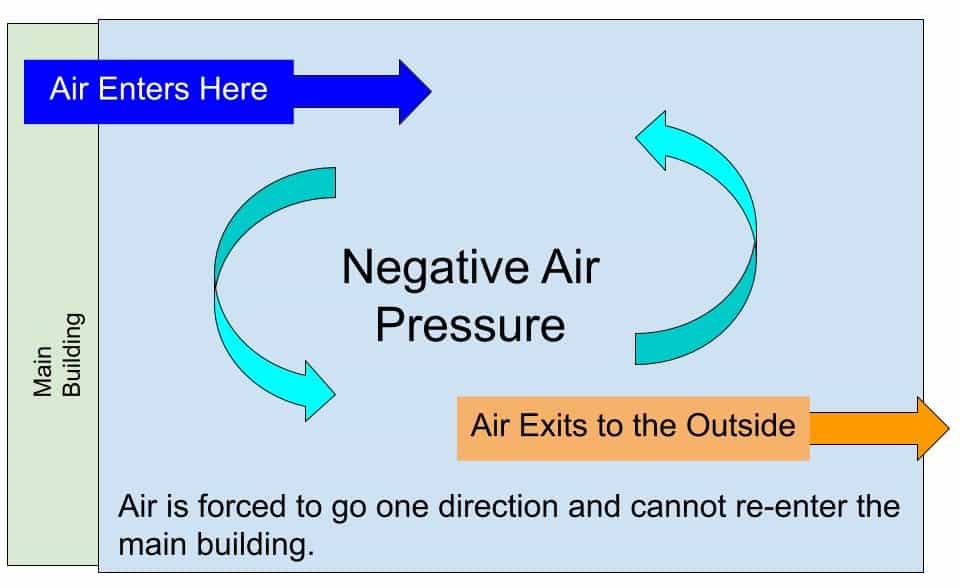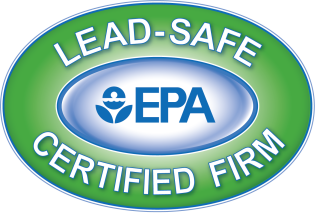Yea! Time for new floors! Wait, what is this? Another layer of floor? One of the more common areas we find asbestos in homes is in vinyl floor tiles. Asbestos is found in the tiles themselves as well as the mastic used to adhere them to the floor. The next question becomes, do I have to remove the tiles, or can I just put the new floor on top of them? The answer is not so simple, but we have the answers for all your questions!
DO THE FLOOR TILES CONTAIN ASBESTOS?

The first question to answer is if the tiles have asbestos or not. Many tiles in older homes do contain asbestos, and there is no way to tell just by looking.
The most common tiles that are positive are ones that measure 9”x 9”. Mastic that is black is also a tell-tale sign.
While those are the most common asbestos containing floor tiles, many other tiles and floor coverings can be positive as well. Despite common misconceptions, even new vinyl flooring can contain asbestos.
If you want to know for sure, you can have an asbestos survey conducted, or send a sample for analysis.
HOW DANGEROUS ARE ASBESTOS FLOOR TILES?
Once you have confirmed that you do in fact have asbestos floor tiles, it is helpful to understand a little more about the threat they present.
Asbestos is a fiber that is harmful when it is breathed into your lungs.6 If the floor tiles are intact and undamaged, there is very little risk that fibers are being released into your home.
If the floor tiles are degraded and crumbling, the risk of fiber release rises.
Often the tiles are in good condition, but begin to crumble when tack strips are pulled up from the carpet installation.
CAN I PUT A NEW FLOOR ON TOP OF ASBESTOS TILES?
When you are dealing with asbestos, you can either remove it with an abatement or manage it in place. In many cases, installing a new floor over the tiles encapsulates the asbestos fibers, and is an acceptable way to manage the material.
That said, it can be difficult to get a level surface for the new floor, especially if the old tiles have chipped away. If you are hiring a flooring company, they may be hesitant to work around asbestos tiles, and require you to get an abatement first.
CAN I REMOVE THE DAMAGED TILES MYSELF?
In Georgia, if you:
- Own the home
- Are doing the work yourself
- You will be the one occupying the dwelling
Then, you are allowed to remove the tiles without hiring an asbestos contractor. Depending on the extent of the damaged tiles, this may not be a good idea. In cases where there are only a few pieces of damaged tiles, you can pick them up and bag them.

However, there is no safe level of exposure to asbestos according to OSHA.1 According to the EPA, when working with asbestos, you should wear personal protective gear that includes:
- Coveralls
- Head and foot covers made of a disposable synthetic fabric
- Gloves
- Full face respirator, which has been checked for fit and you have been trained to use. 5
You will still need to be sure to dispose of the tiles in accordance with solid waste disposal regulations. Asbestos waste must be double bagged, labeled, and taken to a permitted landfill. To learn more about disposal regulations see our post: How To Follow Asbestos Regulations.
If you have more than a few pieces of tile, or if the tiles have begun to crumble into small pieces, it is a good idea to call in the pros. Properly removing the old mastic is often beyond the scope of a DIY project, and most homeowners do not have vacuums that can safely clean any fibers that may remain.
HOW DO YOU ABATE FLOOR TILES AND MASTIC?
The first step to any abatement is establishing containment. The work area is contained with plastic barrier walls and negative air flow is used.1 Negative air flow is when air enters a room and is pulled through the room, but does not re-enter the building.1 Clean air is pulled into the room, and is then expelled to the outdoors.1 This is important to keep contaminants like asbestos fibers, mold spores, viruses (like COVID-19), volatile organic compounds (VOC’s), microbial volatile organic compounds (mvoc’s), dust, and other small particles from entering your home during the work.2,3 These measures ensure that no asbestos fibers contaminate your home or worksite.

Working under containment in proper protective gear, the floor tile is then chipped away and removed. After the floor tile is gone, solvents are used to remove the mastic.
A final cleaning and HEPA vacuuming of all surfaces within the containment zone ensures no fibers remain.
Choosing the Right Contractor
You may feel a bit overwhelmed when you discover that you have asbestos floor tiles. We understand that asbestos is a setback you were not expecting and don’t want to be dealing with. Working with the right asbestos contractor, however, can help you navigate the project efficiently and economically.
Be sure you find a professional who will listen to your objectives and talk you through all the options you have. Don’t settle for a contractor that is only trying to sell you their services!
While asbestos presents a very real health hazard, it is also something that can be managed and the risk can be mitigated. Your asbestos contractor should be your advocate, and work towards the ultimate goal of providing you a safe environment to live in.
CALL BRANCH ENVIRONMENTAL
As a company, we believe that nobody should live or work in a building that makes them sick. We take every precaution to protect your health and the health of your family. We are experts in environmental safety and air quality, with over 25 years of experience. We treat your home or business like our own. Call us to schedule an inspection today!

